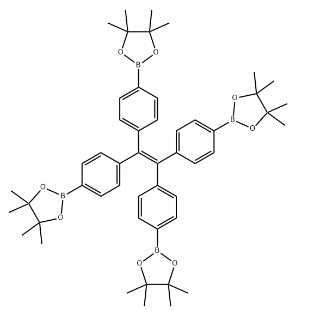

IdentificationPhysical DataSpectraRoute of Synthesis (ROS)Safety and HazardsOther Data
Identification
Product Name1,1,2,2-Tetrakis(4-(4,4,5,5-tetramethyl-1,3,2-dioxaborolan-2-yl)phenyl)etheneIUPAC Name4,4,5,5-tetramethyl-2-ethenyl]phenyl]-1,3,2-dioxaborolane Molecular StructureCAS Registry Number 1660996-72-4Synonyms1,1,2,2-Tetrakis(4-(4,4,5,5-tetramethyl-1,3,2-dioxaborolan-2-yl)phenyl)ethene1660996-72-4YSZC726MFCD317007654,4,5,5-tetramethyl-2-ethenyl]phenyl]-1,3,2-dioxaborolaneAS-85909CS-0110315E743672,2',2'',2'''-(1,1,2,2-Ethenetetrayltetra-4,1-phenylene)tetrakis(4,4,5,5-tetramethyl-1,3,2-dioxaborolane)Molecular FormulaC50H64B4O8Molecular Weight836.3 InChIInChI=1S/C50H64B4O8/c1-43(2)44(3,4)56-51(55-43)37-25-17-33(18-26-37)41(34-19-27-38(28-20-34)52-57-45(5,6)46(7,8)58-52)42(35-21-29-39(30-22-35)53-59-47(9,10)48(11,12)60-53)36-23-31-40(32-24-36)54-61-49(13,14)50(15,16)62-54/h17-32H,1-16H3InChI KeyIMKQIUDDYPXPIU-UHFFFAOYSA-NSMILESB1(OC(C(O1)(C)C)(C)C)C2=CC=C(C=C2)C(=C(C3=CC=C(C=C3)B4OC(C(O4)(C)C)(C)C)C5=CC=C(C=C5)B6OC(C(O6)(C)C)(C)C)C7=CC=C(C=C7)B8OC(C(O8)(C)C)(C)C
Physical Data
No data available
Spectra
Description (NMR Spectroscopy)Nucleus (NMR Spectroscopy)Solvents (NMR Spectroscopy)Temperature (NMR Spectroscopy), °C Frequency (NMR Spectroscopy), MHzChemical shifts, Spectrum1Hchloroform-d124.84Chemical shifts, Spectrum1Hchloroform-d1Chemical shifts1Hchloroform-d1400Chemical shifts1Hchloroform-d1300Chemical shifts1Hchloroform-d1400Chemical shifts1Hchloroform-d1Chemical shifts13Cchloroform-d1
1,1,2,2-Tetrakis(4-(4,4,5,5-tetramethyl-1,3,2-dioxaborolan-2-yl)phenyl)ethene CAS#: 1660996-72-4 NMR
Description (IR Spectroscopy)Solvent (IR Spectroscopy)Bandspotassium bromideBands, Spectrum
Route of Synthesis (ROS)
Route of Synthesis (ROS) of 1,1,2,2-Tetrakis(4-(4,4,5,5-tetramethyl-1,3,2-dioxaborolan-2-yl)phenyl)ethene CAS 1660996-72-4
ConditionsYieldStage #1: 1,1,2,2-tetrakis(4-bromophenyl)ethene; bis(pinacol)diborane With potassium acetate In 1,4-dioxane for 1h; Inert atmosphere;Stage #2: With (1,1'-bis(diphenylphosphino)ferrocene)palladium(II) dichloride In 1,4-dioxane Inert atmosphere;Experimental Procedure5.1 (1) Preparation of tetrakis (pinacol borate) tetraphenylenePut tetrabromotetraphenylethylene (0.1mmol), bipinacol borate (1.0mmol), potassium acetate (1mmol) into the 1,4-dioxane solvent single-neck bottle equipped with 30mL, pass nitrogen 60 minute. Weigh 1,1'-bisdiphenylphosphinoferrocene palladium dichloride, put it into the above-mentioned single-necked flask, and let it pass nitrogen for half an hour. Continue heating to reflux in a nitrogen atmosphere overnight, cool the reaction system, pour the reaction solution into a beaker containing 500 mL of water, and extract with dichloromethane. The organic phase was collected and dried, mixed with silica gel, and sampled by dry method, and purified by column using dichloromethane/methanol (volume ratio of 10:1) as a developing solvent to obtain the intermediate tetrakis (pinacol borate) tetraphenyl Ethylene, 85% yield.85%With (1,1'-bis(diphenylphosphino)ferrocene)palladium(II) dichloride; potassium acetate In 1,4-dioxane Inert atmosphere; Reflux;Experimental Procedure5.1 (1) Preparation of tetrakis (pinacol borate) tetraphenylenePut tetrabromotetraphenylethylene (0.1mmol), bipinacol borate (1.0mmol), potassium acetate (1mmol) into the 1,4-dioxane solvent single-neck bottle equipped with 30mL, pass nitrogen 60 minute. Weigh 1,1'-bisdiphenylphosphinoferrocene palladium dichloride, put it into the above-mentioned single-necked flask, and let it pass nitrogen for half an hour. Continue heating to reflux in a nitrogen atmosphere overnight, cool the reaction system, pour the reaction solution into a beaker containing 500 mL of water, and extract with dichloromethane. The organic phase was collected and dried, mixed with silica gel, and sampled by dry method, and purified by column using dichloromethane/methanol (volume ratio of 10:1) as a developing solvent to obtain the intermediate tetrakis (pinacol borate) tetraphenyl Ethylene, 85% yield.85%With dichloro(1,1'-bis(diphenylphosphanyl)ferrocene)palladium(II)*CH2Cl2; potassium acetate In 1,4-dioxane at 110℃; for 72h; Inert atmosphere;83%
Safety and Hazards
GHS Hazard StatementsNot Classified
Other Data
TransportationUnder the room temperature and away from lightHS CodeStorageUnder the room temperature and away from lightShelf Life1 yearMarket Price
DruglikenessLipinski rules componentMolecular Weight836.297logP-14.8HBA8HBD0Matching Lipinski Rules2Veber rules componentPolar Surface Area (PSA)73.84Rotatable Bond (RotB)8Matching Veber Rules2
Use Pattern1,1,2,2-Tetrakis(4-(4,4,5,5-tetramethyl-1,3,2-dioxaborolan-2-yl)phenyl)ethene has important applications in the field of materials science. It serves as a starting material for the synthesis of organic semiconductor materials, fluorescent materials, and light-emitting diode materials. By modifying and functionalizing its structure, the optical, electronic, and conductivity properties of materials can be controlled, enabling their use in optoelectronic devices, light sensors, organic solar cells, and other fields. https://www.chemwhat.com/1122-tetrakis4-4455-tetramethyl-132-dioxaborolan-2-ylphenylethene-cas-1660996-72-4/
Comments
Post a Comment